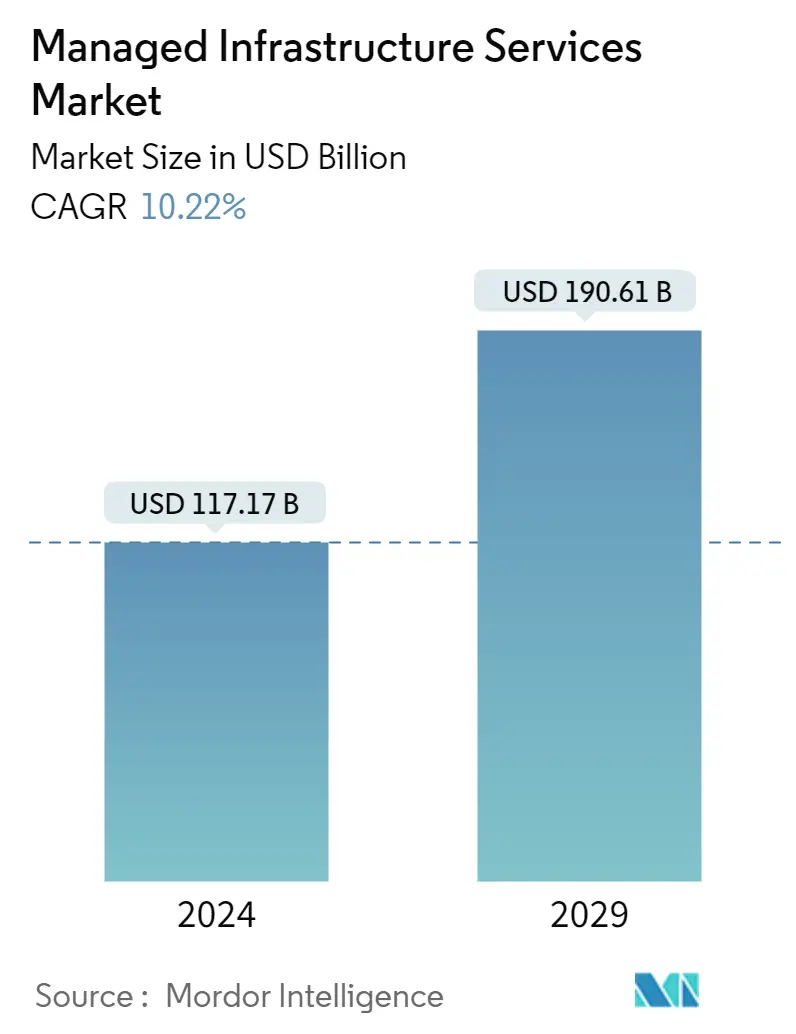Market Size of Managed Infrastructure Services Industry

| Study Period | 2019-2029 |
| Market Size (2024) | USD 117.17 Billion |
| Market Size (2029) | USD 190.61 Billion |
| CAGR (2024 - 2029) | 10.22 % |
| Fastest Growing Market | Asia Pacific |
| Largest Market | North America |
| Market Concentration | Low |
Major Players
*Disclaimer: Major Players sorted in no particular order |
Managed Infrastructure Services Market Analysis
The Managed Infrastructure Services Market size is estimated at USD 117.17 billion in 2024, and is expected to reach USD 190.61 billion by 2029, growing at a CAGR of 10.22% during the forecast period (2024-2029).
Technology trends such as analytics, Cloud, IoT, and Cognitive Computing are creating new business imperatives. Companies are adopting these digital technologies to build innovative business models, optimize business processes, empower their workforce, and personalize the customer experience.
- Redundant downtime is reduced through managed services, which offer specialized value-added services like application testing, service catalog creation, and professional consulting. The market's development is aided by various monitoring tools and numerous layers of infrastructure controlled by separate teams. For instance, in BMC's "BMC Helix ITSM" the system is centralized, cloud-native, connected with observability, and optimized for AIOps. This solution fully exposes data from monitoring tools for IT infrastructure, application performance, network performance, and cloud services. Additionally, team and individual dashboards are customized to each user's needs.
- Technological proliferation and advancement of cloud-based technology boosting the demand is driving the market. Over the past few years, daily operations of break-fix and troubleshooting of servers have been outsourced to reduce their attention over IT, thereby allowing the expertise of IT service vendors. An increase in the adoption of digital transformation with mobility and cloud has led to infrastructure modernization. The need to keep up with the latest technological enhancements has led organizations to opt for infrastructure-managed services.
- Improved cost and operational efficiency and updates of outdated hardware are driving the market. Managed services offer several benefits, relentless focus on continuous improvement of operational and business processes being the most significant one. According to Cisco Systems, managed services reduce recurring in-house costs by 30-40% and increase efficiency by 50-60%. Moreover, as new and enhanced equipment is introduced to the infrastructure, the old hardware might not always be compatible. As data center operations increase, the hardware could become more of a liability which slows down operations, than an asset that enhances them.
- Declining profit margins and integration and reliability concerns are restraining the market to grow. Emerging technologies, such as mobility and cloud computing, are rapidly changing the business landscape. Companies have to be in sync with these technologies to deliver desired benefits to the customers. Reliability concerns are also challenging the market to grow when hiring another partner to host critical business infrastructure.
- Businesses are putting a lot of attention on remote working due to the COVID-19 pandemic. The use of cloud services grew significantly as companies became more concerned with maintaining operations during lockdowns imposed by various governments to stop the spread of the coronavirus. In anticipation of cloud migration becoming more widespread among corporations and, in some cases, even gaining traction, most businesses have already renewed their contracts with managed cloud service providers. Additionally, businesses and organizations prioritized integrating cutting-edge technologies like augmented reality and machine learning into their current IT infrastructure to promote digital transformation.
Managed Infrastructure Services Industry Segmentation
Managed infrastructure services refer to outsourcing an organization's infrastructure and inventory activities to a third-party managed service provider (MSP). These services are often taken on a contract basis, where the MSP has to fulfill a set of agreed standards to benefit from the contract. These practices are typically found in large-scale and small-scale organizations for desktop & print services contracts, servers, etc.
The managed infrastructure services market is segmented by deployment type (on-premise and cloud), services type (desktop and print services, servers, inventory), end-user (BFSI, IT, telecom, healthcare, manufacturing, retail), and geography (North America (United States, Canada), Europe (Germany, UK, France, Spain, and rest of Europe), Asia-Pacific (China, Japan, India, Australia, and rest of Asia-Pacific), and Latin America (Brazil, Mexico, Argentina, and rest of Latin America), and Middle East & Africa (UAE, Saudi Arabia, South Africa, and rest of MEA).
The market sizes and forecasts are provided in terms of value in USD for all the above segments.
| By Deployment Type | |
| On-premise | |
| Cloud |
| By Services Type | |
| Desktop and Print Services | |
| Servers | |
| Inventory | |
| Other Types |
| By End User | |
| BFSI | |
| IT and Telecom | |
| Healthcare | |
| Manufacturing | |
| Retail | |
| Other End Users |
| By Geography | |||||||
| |||||||
| |||||||
| |||||||
| |||||||
|
Managed Infrastructure Services Market Size Summary
The managed infrastructure services market is poised for significant growth, driven by the increasing adoption of digital technologies such as cloud computing, IoT, and cognitive computing. These technologies are enabling businesses to innovate their models, streamline processes, and enhance customer experiences. Managed services are crucial in minimizing downtime and offering specialized services like application testing and professional consulting. The market is further bolstered by advancements in cloud-based technologies, which have led to the outsourcing of IT operations to focus on core business activities. This shift towards digital transformation and infrastructure modernization is essential for organizations to stay competitive and leverage the latest technological enhancements.
The market landscape is characterized by a high level of fragmentation, with numerous established players competing vigorously. Companies are forming strategic partnerships to enhance their service offerings and maintain a competitive edge. The Asia-Pacific region is witnessing substantial growth due to rapid digitization and the adoption of cloud technologies, with countries like India and China leading the charge. The region's commitment to advancing digital infrastructure makes it an attractive hub for managed infrastructure services. Despite challenges such as declining profit margins and reliability concerns, the market is expected to expand as businesses increasingly prioritize cloud migration and digital transformation to meet evolving consumer demands.
Managed Infrastructure Services Market Size - Table of Contents
-
1. MARKET INSIGHTS
-
1.1 Market Overview
-
1.2 Industry Stakeholder Analysis
-
1.3 Industry Attractiveness - Porter's Five Forces Analysis
-
1.3.1 Bargaining Power of Suppliers
-
1.3.2 Bargaining Power of Consumers
-
1.3.3 Threat of New Entrants
-
1.3.4 Threat of Substitute Products
-
1.3.5 Intensity of Competitive Rivalry
-
-
-
2. MARKET SEGMENTATION
-
2.1 By Deployment Type
-
2.1.1 On-premise
-
2.1.2 Cloud
-
-
2.2 By Services Type
-
2.2.1 Desktop and Print Services
-
2.2.2 Servers
-
2.2.3 Inventory
-
2.2.4 Other Types
-
-
2.3 By End User
-
2.3.1 BFSI
-
2.3.2 IT and Telecom
-
2.3.3 Healthcare
-
2.3.4 Manufacturing
-
2.3.5 Retail
-
2.3.6 Other End Users
-
-
2.4 By Geography
-
2.4.1 North America
-
2.4.1.1 United States
-
2.4.1.2 Canada
-
-
2.4.2 Europe
-
2.4.2.1 Germany
-
2.4.2.2 UK
-
2.4.2.3 France
-
2.4.2.4 Spain
-
2.4.2.5 Rest of Europe
-
-
2.4.3 Asia-Pacific
-
2.4.3.1 China
-
2.4.3.2 Japan
-
2.4.3.3 India
-
2.4.3.4 Australia
-
2.4.3.5 Rest of Asia-Pacific
-
-
2.4.4 Latin America
-
2.4.4.1 Brazil
-
2.4.4.2 Mexico
-
2.4.4.3 Argentina
-
2.4.4.4 Rest of Latin America
-
-
2.4.5 Middle East and Africa
-
2.4.5.1 UAE
-
2.4.5.2 Saudi Arabia
-
2.4.5.3 South Africa
-
2.4.5.4 Rest of Middle East and Africa
-
-
-
Managed Infrastructure Services Market Size FAQs
How big is the Managed Infrastructure Services Market?
The Managed Infrastructure Services Market size is expected to reach USD 117.17 billion in 2024 and grow at a CAGR of 10.22% to reach USD 190.61 billion by 2029.
What is the current Managed Infrastructure Services Market size?
In 2024, the Managed Infrastructure Services Market size is expected to reach USD 117.17 billion.

